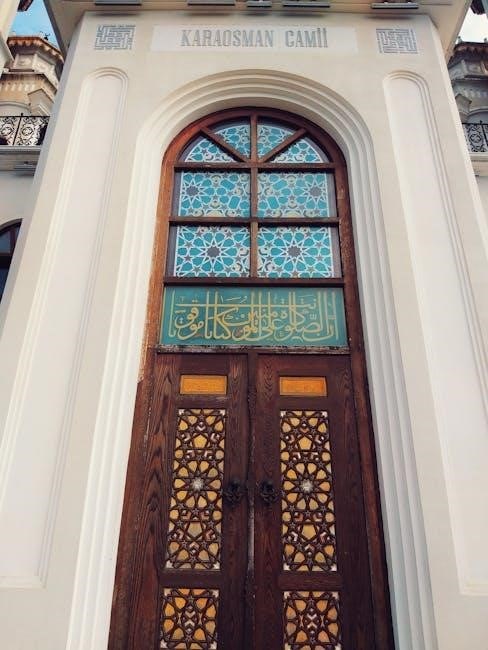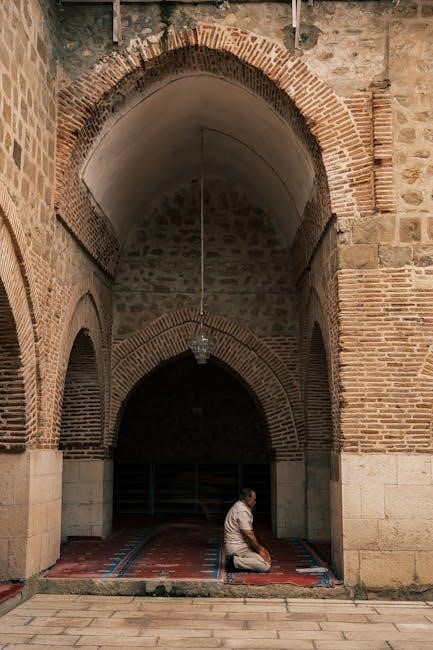
The Yizkor Prayer is a solemn Jewish tradition honoring deceased loved ones. A Yizkor Prayer PDF provides the Hebrew text, English translation, and commentary, making it accessible for personal reflection and communal services.
What is the Yizkor Prayer?
The Yizkor Prayer is a sacred Jewish memorial service recited four times annually during major holidays, including Yom Kippur, Passover, Shavuot, and Shemini Atzeret. Its name, derived from the Hebrew word “Yizkor” (May God Remember), reflects its purpose of honoring the memory of deceased loved ones and martyrs. The prayer is a heartfelt expression of remembrance, gratitude, and spiritual connection to those who have passed. It typically includes sections for parents, spouses, children, and community members, with a focus on their contributions and the legacy they left behind. The Yizkor Prayer PDF provides a structured format, often featuring the Hebrew text, English translations, and explanatory notes, making it accessible for both experienced worshippers and those less familiar with the tradition. This prayer is a profound way to ensure the memories of loved ones endure and their spirits remain bound in the bonds of eternal life.
The Purpose of the Yizkor Prayer
The purpose of the Yizkor Prayer is to honor and remember the souls of loved ones who have passed, ensuring their memories endure. It serves as a meaningful way to express grief, gratitude, and spiritual connection. Recited during significant Jewish holidays, Yizkor provides comfort to mourners and strengthens their bond with the deceased. The prayer emphasizes the belief that the souls of the departed continue to exist in the spiritual realm and are bound to the living through acts of remembrance and charity. By reciting Yizkor, individuals affirm their commitment to uphold the values and traditions passed down by their loved ones. The structured format of the Yizkor Prayer PDF helps guide worshippers through this sacred ritual, ensuring the memories of the departed remain a blessing for generations to come. This prayer is a profound expression of love, respect, and continuity, bridging the gap between the living and the departed.
The Significance and Purpose of Yizkor
Yizkor, a sacred memorial prayer, honors loved ones by invoking their memory and connecting their souls to eternal divine remembrance. A Yizkor Prayer PDF guides worshippers, ensuring accessibility and proper recitation, fostering emotional and spiritual connection.
Yizkor as a Memorial Service
Yizkor serves as a poignant memorial service, recited four times annually in synagogues during significant Jewish holidays. It provides a sacred space for mourners to honor their departed loved ones, fostering emotional and spiritual connection. The prayer’s structure, often guided by a Yizkor Prayer PDF, includes reflections on memories, legacies, and the enduring impact of those who have passed. By invoking their names and deeds, participants seek to bind their souls to eternal remembrance. This communal ritual strengthens communal bonds and offers solace to those in grief. The use of a PDF ensures accessibility, preserving traditions while adapting to modern needs. Yizkor’s profound significance lies in its ability to heal and connect, ensuring the memories of the departed continue to inspire and guide the living.
The Emotional and Spiritual Impact of Yizkor
Reciting the Yizkor Prayer evokes profound emotional and spiritual resonance, offering comfort to mourners and deepening their connection to loved ones who have passed. The prayer’s solemn and reflective nature fosters a sense of unity, as individuals and communities come together to honor memories. Many find solace in the structured recitation, which provides a meaningful way to process grief. The use of a Yizkor Prayer PDF enhances accessibility, allowing individuals to reflect privately or within a congregation. Spiritually, Yizkor strengthens faith and provides a sense of continuity, linking the living with the deceased. It also encourages introspection and gratitude, helping individuals find meaning in their loss. This sacred ritual transcends time, bridging the gap between past and present, and offers a path toward healing and enduring remembrance.

The Structure of the Yizkor Prayer

The Yizkor Prayer consists of opening blessings, central memorial prayers, and closing reflections. A Yizkor Prayer PDF outlines these sections clearly, guiding participants through the sacred ritual with ease and clarity.

The Opening of the Yizkor Service
The Yizkor service begins with solemn prayers and blessings, setting a reverent tone. A Yizkor Prayer PDF typically includes the opening blessings and the “Yizkor Elokim” prayer, which requests divine remembrance for departed souls. Participants often stand during key sections, reflecting on their loved ones. The opening may also include Psalms and reflective readings, fostering a connection to heritage. The PDF guide ensures accessibility, offering Hebrew text, English translations, and insightful commentary. This structured start invites worshippers to embrace the sacred ritual, honoring memories while seeking spiritual solace.
Key Sections of the Yizkor Prayer
The Yizkor Prayer includes several key sections that serve as its foundation. The prayer begins with “Yizkor Elokim,” a heartfelt request for divine remembrance of departed souls. This section is often recited for parents, with specific mentions of their roles as guides and sources of wisdom. Another central part is “Yizkor le-Kaddish,” which honors the memory of other loved ones, emphasizing their impact on the lives they touched. The prayer also includes “El Malei Rachamim,” a poignant plea for mercy and peace for the deceased, and “Av HaRachamim,” a stirring remembrance of Jewish martyrs. These sections are designed to evoke reflection and emotional connection. A Yizkor Prayer PDF typically includes these core elements, ensuring participants can follow along with clarity and intention, fostering a meaningful experience of remembrance and spiritual renewal.

When and Where Yizkor is Recited
Yizkor is recited in synagogues four times annually: on Yom Kippur, the last day of Passover, Shavuot, and Shemini Atzeret. It follows Torah reading, serving as a memorial service for loved ones.
Timing of Yizkor in the Jewish Calendar
The Yizkor Prayer is recited four times annually in the Jewish calendar, following specific sacred moments. It is observed on Yom Kippur, the Day of Atonement, when the community seeks forgiveness and reflects on loved ones who have passed. Additionally, Yizkor is recited on the last day of Passover, symbolizing the transition from freedom to remembrance, and on Shavuot, the Festival of Weeks, which honors the giving of the Torah and the cycle of life. The fourth observance occurs on Shemini Atzeret, the final day of Sukkot, marking the conclusion of the High Holy Day season. These timings emphasize the connection between communal reflection, personal loss, and spiritual renewal. The Yizkor Prayer PDF often includes the specific dates and order of recitation, ensuring participants can follow the tradition accurately. This structured schedule allows individuals and communities to honor their loved ones in harmony with Jewish tradition and the annual cycle of holidays.
Special Occasions for Reciting Yizkor
Beyond the four annual recitations, Yizkor is also recited during special occasions to honor the memory of loved ones. One such occasion is the Yahrzeit, the anniversary of a loved one’s passing, when individuals recite Yizkor to commemorate their memory. Additionally, Yizkor is included in memorial services for victims of the Holocaust, known as Yom HaShoah, and for fallen IDF soldiers on Yom HaZikaron. These services emphasize collective remembrance and communal healing. Some communities also recite Yizkor during the 9th of Av, a day of mourning for historical tragedies. Furthermore, Yizkor is sometimes recited at graveside services or during visits to cemeteries, especially during the High Holy Days. A Yizkor Prayer PDF often includes specific sections for these occasions, providing guidance for those seeking to honor their loved ones in meaningful ways. These special recitations highlight the prayer’s adaptability to various moments of remembrance and reflection.

The History and Evolution of Yizkor

The Yizkor Prayer has ancient roots, evolving from traditional memorials to honor martyrs and loved ones. Over time, it incorporated personal reflections, becoming a meaningful way to connect with ancestors and heritage.
Origins of the Yizkor Prayer
The Yizkor Prayer traces its origins to the 11th century in Mainz, Germany, where Rabbi Amnon of Mainz is credited with its creation. Initially recited to honor martyrs of the Crusades, it later evolved to include personal remembrance of loved ones. The prayer’s name, “Yizkor” (“May God remember”), reflects its central theme of invoking divine remembrance for the souls of the deceased. Over time, Yizkor became an integral part of Jewish liturgy, particularly during major holidays like Yom Kippur, Passover, and Shavuot. Its structure and content have been refined over centuries, blending traditional mourning practices with personal reflection. Today, the Yizkor Prayer is a powerful expression of memory, faith, and connection to one’s heritage, offering solace to mourners and a bridge between the living and the departed;
Modern Adaptations of Yizkor
In contemporary times, the Yizkor Prayer has evolved to accommodate diverse Jewish communities and technological advancements. A Yizkor Prayer PDF is widely used, offering accessible formats with Hebrew text, English translations, and interpretive commentary. This digital adaptation ensures the prayer remains relevant and easily shareable across generations. Many synagogues now incorporate inclusive language, allowing participants to honor not only immediate family but also extended relatives and friends. Additionally, virtual Yizkor services have become common, enabling global participation. These modern adaptations maintain the prayer’s traditional essence while addressing the needs of a changing world. By blending ancient traditions with modern tools, the Yizkor Prayer continues to serve as a meaningful way to connect with loved ones who have passed, fostering a sense of continuity and shared memory.
How to Participate in Yizkor
To participate in Yizkor, recite the prayer with intention, focusing on memories of loved ones. Use a Yizkor Prayer PDF for guidance, ensuring proper recitation and emotional connection.

Preparation for Reciting Yizkor
Preparing for Yizkor involves reflection and emotional readiness. Review the Yizkor Prayer PDF to familiarize yourself with the text and its meaning. Consider the loved ones you wish to honor, recalling their qualities and the impact they had on your life. Many find it helpful to write down names and memories beforehand to maintain focus during the prayer. Traditionally, it is customary to light a candle or give charity in their memory, acts that are often mentioned within the PDF as part of the preparation process. Approach the prayer with sincerity, allowing yourself to connect deeply with the words and the memories they evoke. This mindfulness ensures that the recitation is both meaningful and heartfelt.

Guidelines for Reciting Yizkor
Reciting Yizkor follows specific customs to ensure its meaningfulness. The Yizkor Prayer PDF guides participants through the traditional text, emphasizing the importance of focus and intention. It is customary to stand during the prayer and to recite it aloud or quietly, depending on communal practice. Men are required to wear a tallit, while women may choose to do so. The PDF often includes instructions for separating prayers for men and women, as well as mentioning each name individually. It is also a tradition to refrain from speaking during the recitation and to maintain a respectful silence. Many communities encourage mourners to lead the service or recite specific sections. The PDF serves as a valuable resource, ensuring that all participants can follow along and fulfill the mitzvah of honoring the deceased with dignity and devotion.
Yizkor Prayer in PDF Format
The Yizkor Prayer PDF offers a comprehensive and accessible resource for reciting the prayer. It includes the full Hebrew text, English translations, and commentary, making it ideal for both personal and communal use.
Benefits of Using a Yizkor Prayer PDF
Using a Yizkor Prayer PDF offers numerous advantages, particularly for those seeking to honor their loved ones with precision and meaning. Firstly, it provides a clear and organized format, ensuring that all sections of the prayer are easily accessible. The PDF often includes both the Hebrew text and its English translation, catering to individuals with varying levels of proficiency in Hebrew. Additionally, it frequently incorporates transliterations, making it easier for those who are less familiar with the language to recite the prayers accurately. Many PDF versions also include commentary and explanations, offering deeper insights into the historical and spiritual significance of the Yizkor service. This feature is especially beneficial for those who wish to understand the context and emotions behind the prayers. Moreover, the digital format allows for easy sharing and access, enabling individuals to participate in the service from any location, whether in a synagogue or at home. The portability of the PDF ensures that one can refer to it whenever needed, fostering a sense of connection and continuity with tradition. Overall, a Yizkor Prayer PDF serves as a valuable resource, enhancing both the accessibility and the profound experience of the Yizkor service.
How to Access or Create a Yizkor Prayer PDF

Accessing or creating a Yizkor Prayer PDF is a straightforward process that ensures you have a convenient and organized resource for reciting the prayer. Many Jewish organizations, such as Chabad and MyJewishLearning, offer free downloadable Yizkor Prayer PDFs on their websites. These documents typically include the Hebrew text, English translations, and transliterations, making them accessible to a wide audience. Additionally, you can find Yizkor Prayer PDFs on digital libraries and religious websites, often formatted for easy reading and printing. If you wish to create your own, you can use a word processor like Microsoft Word or Google Docs to compile the prayer text, adding personal touches such as photos or meaningful quotes. Some platforms also offer templates or design tools to enhance the visual appeal of the document. Once created, the PDF can be shared with family or congregation members, ensuring everyone can participate in the service seamlessly.